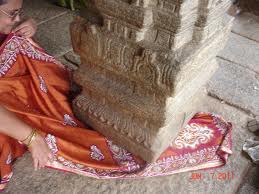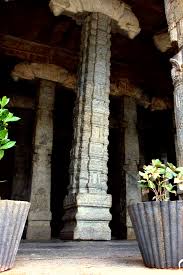when you visit Vijayanagar-era templeLepakshi you can see that the guide whipped out a twig from his pocket with a flourish and will say dramatically: “Now I show you best part of Lepakshi temple.” And will get down on his knees before the large grey pillar before us. Bending forward, he will pass the twig slowly under the pillar. From one end to the other! Its WoW no ??? yes its Indian architectural wonders !!!!!!! 
I am saying about Hanging Column or Pillar of Lepakshi temple, located in Anantapur district in southern Andhra Pradesh. It is truth that “This is the pillar which does not rest on the ground fully,”
There are about 70 pillars at this fabulous 16th-century temple of stone in Vijayanagar style, but this one is the best known and a tribute to the engineering genius of ancient and medieval India’s temple builders. However, it is a bit dislodged from its original position — it is said that during the British era, a British engineer tried to move it in an unsuccessful attempt to uncover the secret of its support.
Much of the temple is built on a low, rocky hill called Kurmasailam — which translates to tortoise hill in Telugu, after the shape of the hill. The temple dates back to 1583 and was built by the brothers, Virupanna and Veeranna, who were initially in the service of the Vijayangar kings. However, Puranic lore has it that the Veerabhadra temple was built by the sage Agastya. It has idols of Ganesha, Nandi, Veerabhadra, Shiva, Bhadrakali, Vishnu and Lakshmi.
 Another legend gives the town a significant place in the Ramayana — this was where the bird Jatayu fell, wounded after a futile battle against Ravana who was carrying away Sita. When Sri Rama reached the spot, he saw the bird and said compassionately, “Le Pakshi” — ‘rise, bird’ in Telugu.
Another legend gives the town a significant place in the Ramayana — this was where the bird Jatayu fell, wounded after a futile battle against Ravana who was carrying away Sita. When Sri Rama reached the spot, he saw the bird and said compassionately, “Le Pakshi” — ‘rise, bird’ in Telugu.
Once you reach the temple’s outer enclosure, you will see a mammoth Ganesha — hewn in stone and leaning against a rock. Perpendicular to it is a massive Naga with three coils and seven hoods. It forms a sheltering canopy over a black granite Shivalingam. It’s reckoned by many as the largest Nagalinga in India.
There are two red blotches on the western wall of the inner enclosure, explained by a gory story. Virupanna, the royal treasurer, was accused of drawing funds without the king’s permission from the state treasury to build these shrines. However, he forestalled the enraged king’s punishment by blinding himself, and those maroon spots are said to be the marks left by his bleeding eyes!
The temple’s main deity is Veerabhadra, the fiery god created by Shiva in his rage after the Daksha Yagna and the immolation of Parvathi. There are several forms of Shiva here — a majestic Kankala Murthi, Dakshinamurthi (Guru of Gurus), Tripuranthaka or Tripurasurasamhara (vanquisher of demon Tripura); Ardhanareeshwara (the half-female, half-male form, where Shiva and Parvati are equally represented in one body), etc. Another shrine has the fiery goddess Bhadrakali, though bearing an uncharacteristically serene expression.
The Lepakshi temple also has the finest specimens of mural paintings of the Vijayanagar kings. We were informed that the 24 by 14 ft fresco of Veerabhadra on the ceiling before the main sanctum sanctorum is the largest in India of any single figure. The rest of the frescoes are also beautiful and show an impressive attention to detail with colours strikingly contrasted — black limework against an orange-red background with some green, white, black, and shades of ochre-gold and brown mostly applied to a stucco surface specially treated with lime. The Shiva-Parvathi kalyanam — an enduringly popular subject with traditional Indian artists — finds expression here. However, these frescoes are peeling off in many places and in need of better maintenance and expert restoration.
After the ache in the neck from gazing upwards at these alluring frescoes, we sat down for a while, rubbing our necks, in the splendid Natya Mandapam or dance hall with its superbly sculpted pillars. The Kalyana Mandapam is another hall known for its artistic beauty. Among the many eye-catchers in this temple, the frieze of geese with lotus stalks in their beaks stands out.
The Lepakshi temple is close to the famed pilgrim town of Puttaparthi, From Hyderabad it is about 480 km and about 130 km from Bangalore.
Mar 02, 2014 @ 06:32:35
ghani khmma jijisahiba ji